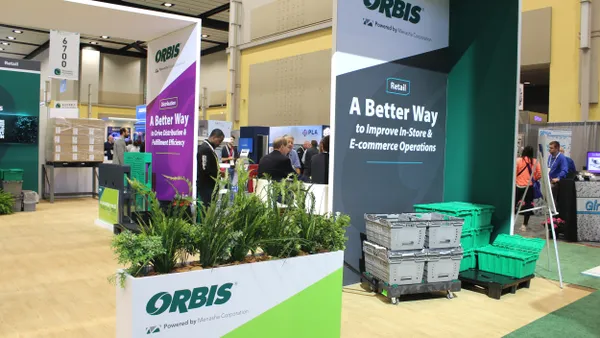Sustainability is increasingly important to the packaging value chain, but consumers view it differently now than they did before the pandemic, according to a report that consulting firm McKinsey released last week.
The survey, which included responses from 11,500 consumers in 11 countries, presents three main findings:
- Hygiene and shelf life are the top factors important to consumers’ purchasing decisions.
- When examining packaging’s environmental impact, consumer concerns about ocean litter are most prominent in Europe, Japan and the United States.
- Consumer views differ on what type of packaging is most sustainable.
“It is clear that packaging companies will need to tailor their approaches to respond to an evolving and varied consumer landscape,” the report said.
Hygiene and safety
Hygiene concerns during the pandemic halted momentum in some regions to reduce single-use packaging. For instance, many restaurants switched from reusable utensils to disposable plastic versions early in the pandemic. But the McKinsey report says most consumers now are shifting away from those heightened hygiene and food safety concerns.
In a 2020 survey, 71% of U.S. residents indicated they were more concerned about hygiene and food safety than before the pandemic, 22% reported the same level of concern and 7% said they were less concerned. This year’s survey showed only 37% said they’re more concerned about hygiene and food safety than before the pandemic, 42% had the same level of concern and 21% are less concerned.
Still, hygiene and food safety was the most important aspect of product packaging for U.S. respondents in 2023, with 75% saying it’s “extremely” important. Shelf life came in second in importance, at 69%, followed by ease of use (57%) and durability (55%); environmental impact was among the two least important factors, at 39%. All the percentages reference respondents indicating an aspect is “extremely” important.
Importance of different aspects of product packaging, respondents indicating “extremely” or “very strong”
| U.S. | UK | Mexico | China | Japan | |
|---|---|---|---|---|---|
| Hygiene & food safety | 75 | 72 | 85 | 87 | 63 |
| Shelf life | 69 | 63 | 82 | 81 | 46 |
| Ease of use | 57 | 51 | 71 | 65 | 35 |
| Durability | 55 | 44 | 69 | 61 | 27 |
| Information included on label | 54 | 47 | 71 | 73 | 36 |
| Environmental impact | 39 | 45 | 71 | 69 | 29 |
| Appearance | 34 | 28 | 52 | 40 | 11 |
Ocean litter
While sustainability pressure builds and packaging manufacturers innovate to improve circularity, consumer concerns about environmental impact differ by region, the report said.
Ocean litter and water pollution are U.S. consumers’ top two environmental concerns, respectively. These categories top the list for nearly a dozen countries, although the ranking of which is in the top slot varies. Consumers in Brazil, India and China also ranked water pollution as their No. 1 concern but had a notably different No. 2 concern than the rest of the pack: air pollution. Ocean litter was the lowest-ranking concern for consumers in India.
Environmental impact importance, respondents indicating “extremely” or “very concerned”
| U.S. | UK | Mexico | Brazil | India | China | |
|---|---|---|---|---|---|---|
| Water pollution | 2 | 5 | 1 | 1 | 1 | 1 |
| Ocean litter | 1 | 1 | 2 | 3 | 7 | 4 |
| Climate change | 5 | 2 | 6 | 7 | 4 | 5 |
| Waste production | 3 | 3 | 7 | 5 | 3 | 3 |
| Air pollution | 4 | 7 | 5 | 2 | 2 | 2 |
| Deforestation | 7 | 4 | 3 | 4 | 6 | 7 |
| Natural resource depletion | 6 | 6 | 4 | 6 | 5 | 6 |
Most respondents across all countries say they were willing to pay more for sustainable packaging, although that sentiment was stronger in developing nations.
Substrates
No single packaging substrate dominated sustainability perceptions across regions among survey respondents. Plastic, glass, metal and paper all are viewed as having both positive and negative features. Although consumers hold different views on which packaging is most sustainable, generally they agree on the least sustainable options.
Compostable and plant-based packaging tended to score highly across regions, holding two of the top three ranks in most countries except Japan. U.S. consumers believe compostable packaging (72%), plant-based packaging (70%) and compostable plastic films made from renewable materials (61%) are extremely sustainable, whereas metal containers (37%), mixed metal-plastic-fiber packaging (28%) and aluminum foil wraps (25%) ranked as least sustainable.
Sustainability of each packaging type, respondents indicating “extremely” or “very strong”
| U.S. | UK | Mexico | China | Japan | |
|---|---|---|---|---|---|
| Compostable packaging | 72 | 74 | 82 | 68 | 61 |
| Plant-based packaging | 70 | 66 | 81 | 70 | 57 |
| Compostable plastic films made from renewable materials | 61 | 54 | 69 | 72 | 61 |
| Paper-based cartons | 59 | 60 | 63 | 59 | 42 |
| Fully recyclable plastic bottles and containers | 56 | 55 | 67 | 66 | 61 |
| Flexible paper | 52 | 63 | 57 | 62 | 39 |
| Glass bottles and jars | 51 | 55 | 54 | 50 | 44 |
| Plastic bottles and containers made from recycled content | 53 | 47 | 62 | 61 | 46 |
| Fully recyclable plastic films | 57 | 54 | 60 | 26 | 59 |
| Metal containers | 37 | 40 | 33 | 50 | 36 |
| Packaging combining plastic, paper, aluminum foil | 28 | 22 | 36 | 42 | 16 |
| Aluminum foil wraps | 25 | 23 | 24 | 37 | 15 |
Recommendations
The report authors say the consumer sentiment landscape is rapidly evolving in the post-pandemic environment, and some divergence is evident across regions and demographics. They recommend that companies develop nuanced strategies to foster growth opportunities.
The authors recommend that companies examine how changes in five key areas could affect products: generational trends, regulatory changes and consumer perception, competitors’ innovation and disruption, unique opportunities and demographic nuances.
A separate report that McKinsey released last week also indicates that demand is growing for recycled plastics and more investment is needed across the value chain to meet demand and circularity goals.












